QI无线充电标准V1.0版
- 格式:doc
- 大小:1.02 MB
- 文档页数:70
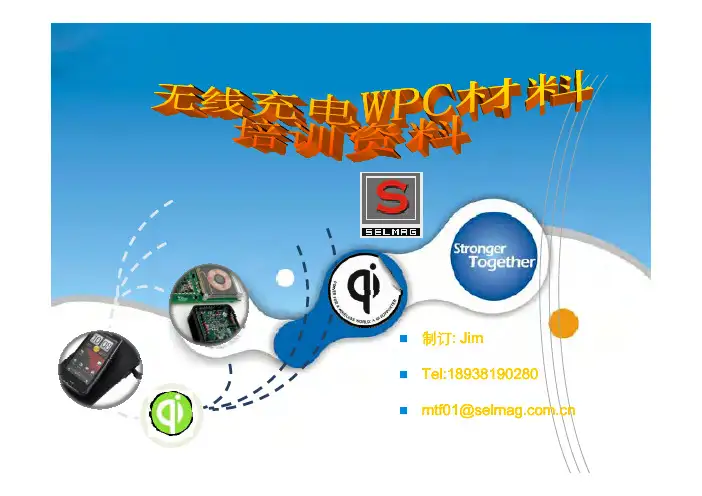
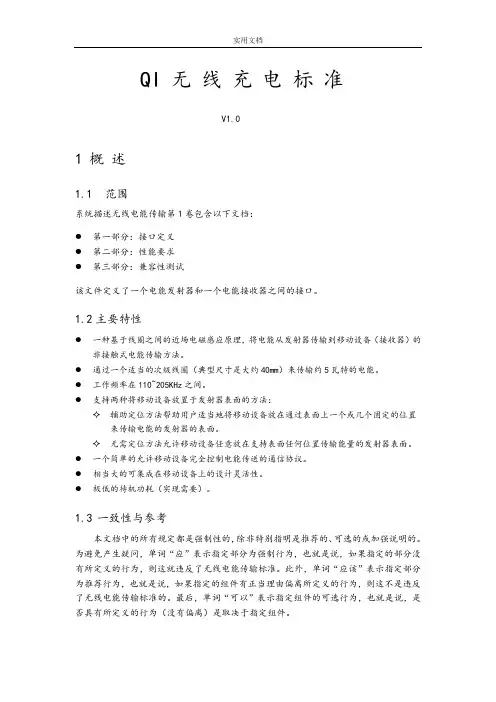
QI无线充电标准V1.01概述1.1范围系统描述无线电能传输第1卷包含以下文档:●第一部分:接口定义●第二部分:性能要求●第三部分:兼容性测试该文件定义了一个电能发射器和一个电能接收器之间的接口。
1.2主要特性●一种基于线圈之间的近场电磁感应原理,将电能从发射器传输到移动设备(接收器)的非接触式电能传输方法。
●通过一个适当的次级线圈(典型尺寸是大约40mm)来传输约5瓦特的电能。
●工作频率在110~205KHz之间。
●支持两种将移动设备放置于发射器表面的方法:✧辅助定位方法帮助用户适当地将移动设备放在通过表面上一个或几个固定的位置来传输电能的发射器的表面。
✧无需定位方法允许移动设备任意放在支持表面任何位置传输能量的发射器表面。
●一个简单的允许移动设备完全控制电能传送的通信协议。
●相当大的可集成在移动设备上的设计灵活性。
●极低的待机功耗(实现需要)。
1.3一致性与参考本文档中的所有规定都是强制性的,除非特别指明是推荐的、可选的或加强说明的。
为避免产生疑问,单词“应”表示指定部分为强制行为,也就是说,如果指定的部分没有所定义的行为,则这就违反了无线电能传输标准。
此外,单词“应该”表示指定部分为推荐行为,也就是说,如果指定的组件有正当理由偏离所定义的行为,则这不是违反了无线电能传输标准的。
最后,单词“可以”表示指定组件的可选行为,也就是说,是否具有所定义的行为(没有偏离)是取决于指定组件。
除本文件所提出的规范外,产品的实现也应符合下面所列出的系统说明所提出的规范。
此外,下列国际标准的相关部分也应遵守。
如果任何系统描述或以下所列出的国际标准存在多个修订版本,以最新版本为准。
[第2部] 无线电能传输系统描述,第I卷,第2部分,性能要求。
[第3 部] 无线电能传输系统描述,第I卷,第3部分,兼容性测试。
[PRMC] 电源接收器制造商代码,无线充电联盟。
[SI] 国际计量制。
1.4定义有效区域:当发射器向移动设备供电时,发射器和接收器各自表面的一部分有足够高的磁场通过的区域。
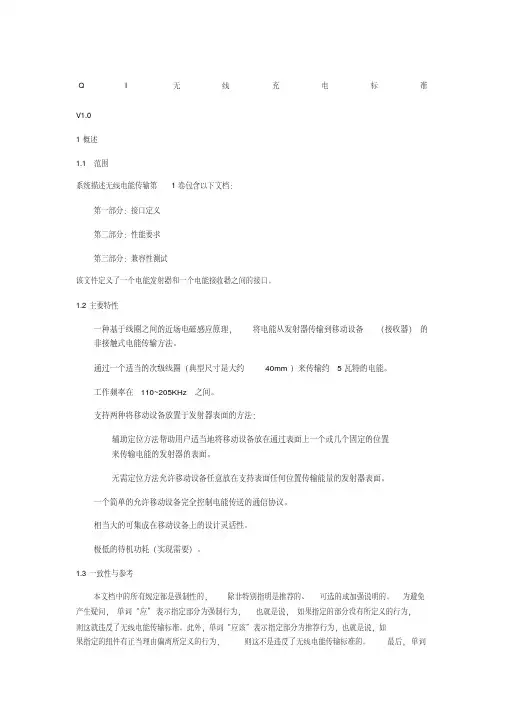
Q I无线充电标准V1.01概述1.1范围系统描述无线电能传输第1卷包含以下文档:第一部分:接口定义第二部分:性能要求第三部分:兼容性测试该文件定义了一个电能发射器和一个电能接收器之间的接口。
1.2主要特性一种基于线圈之间的近场电磁感应原理,将电能从发射器传输到移动设备(接收器)的非接触式电能传输方法。
通过一个适当的次级线圈(典型尺寸是大约40mm)来传输约5瓦特的电能。
工作频率在110~205KHz之间。
支持两种将移动设备放置于发射器表面的方法:辅助定位方法帮助用户适当地将移动设备放在通过表面上一个或几个固定的位置来传输电能的发射器的表面。
无需定位方法允许移动设备任意放在支持表面任何位置传输能量的发射器表面。
一个简单的允许移动设备完全控制电能传送的通信协议。
相当大的可集成在移动设备上的设计灵活性。
极低的待机功耗(实现需要)。
1.3一致性与参考本文档中的所有规定都是强制性的,除非特别指明是推荐的、可选的或加强说明的。
为避免产生疑问,单词“应”表示指定部分为强制行为,也就是说,如果指定的部分没有所定义的行为,则这就违反了无线电能传输标准。
此外,单词“应该”表示指定部分为推荐行为,也就是说,如果指定的组件有正当理由偏离所定义的行为,则这不是违反了无线电能传输标准的。
最后,单词“可以”表示指定组件的可选行为,也就是说,是否具有所定义的行为(没有偏离)是取决于指定组件。
除本文件所提出的规范外,产品的实现也应符合下面所列出的系统说明所提出的规范。
此外,下列国际标准的相关部分也应遵守。
如果任何系统描述或以下所列出的国际标准存在多个修订版本,以最新版本为准。
[第2部]无线电能传输系统描述,第I卷,第2部分,性能要求。
[第3部]无线电能传输系统描述,第I卷,第3部分,兼容性测试。
[PRMC]电源接收器制造商代码,无线充电联盟。
[SI]国际计量制。
1.4定义有效区域:当发射器向移动设备供电时,发射器和接收器各自表面的一部分有足够高的磁场通过的区域。
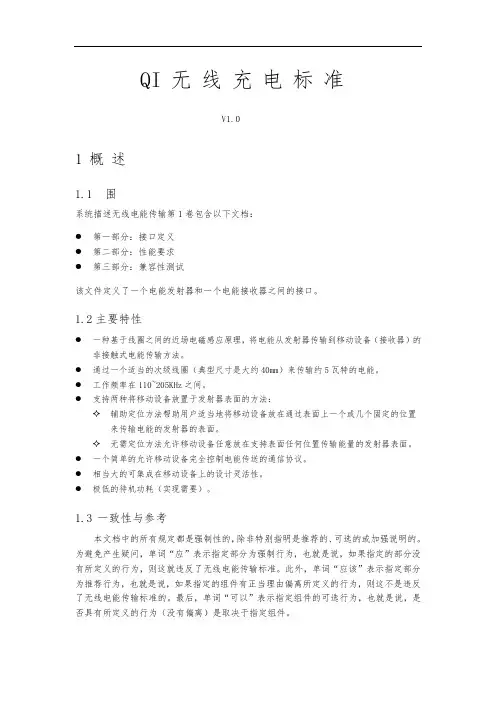
QI无线充电标准V1.01概述1.1围系统描述无线电能传输第1卷包含以下文档:●第一部分:接口定义●第二部分:性能要求●第三部分:兼容性测试该文件定义了一个电能发射器和一个电能接收器之间的接口。
1.2主要特性●一种基于线圈之间的近场电磁感应原理,将电能从发射器传输到移动设备(接收器)的非接触式电能传输方法。
●通过一个适当的次级线圈(典型尺寸是大约40mm)来传输约5瓦特的电能。
●工作频率在110~205KHz之间。
●支持两种将移动设备放置于发射器表面的方法:✧辅助定位方法帮助用户适当地将移动设备放在通过表面上一个或几个固定的位置来传输电能的发射器的表面。
✧无需定位方法允许移动设备任意放在支持表面任何位置传输能量的发射器表面。
●一个简单的允许移动设备完全控制电能传送的通信协议。
●相当大的可集成在移动设备上的设计灵活性。
●极低的待机功耗(实现需要)。
1.3一致性与参考本文档中的所有规定都是强制性的,除非特别指明是推荐的、可选的或加强说明的。
为避免产生疑问,单词“应”表示指定部分为强制行为,也就是说,如果指定的部分没有所定义的行为,则这就违反了无线电能传输标准。
此外,单词“应该”表示指定部分为推荐行为,也就是说,如果指定的组件有正当理由偏离所定义的行为,则这不是违反了无线电能传输标准的。
最后,单词“可以”表示指定组件的可选行为,也就是说,是否具有所定义的行为(没有偏离)是取决于指定组件。
除本文件所提出的规外,产品的实现也应符合下面所列出的系统说明所提出的规。
此外,下列国际标准的相关部分也应遵守。
如果任何系统描述或以下所列出的国际标准存在多个修订版本,以最新版本为准。
[第2部] 无线电能传输系统描述,第I卷,第2部分,性能要求。
[第3 部] 无线电能传输系统描述,第I卷,第3部分,兼容性测试。
[PRMC] 电源接收器制造商代码,无线充电联盟。
[SI] 国际计量制。
1.4定义有效区域:当发射器向移动设备供电时,发射器和接收器各自表面的一部分有足够高的磁场通过的区域。
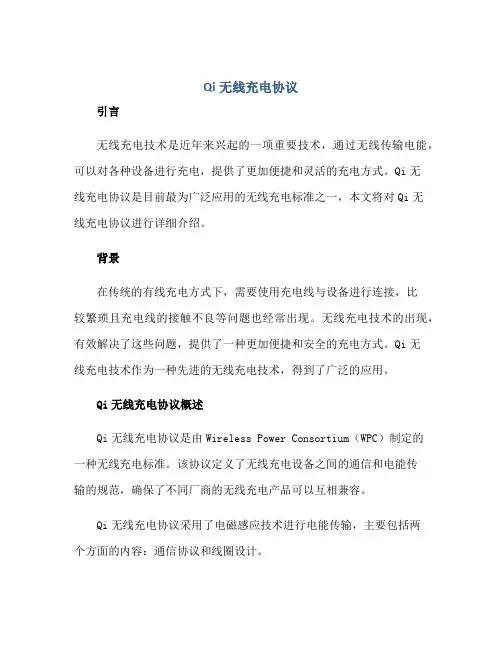
Qi无线充电协议引言无线充电技术是近年来兴起的一项重要技术,通过无线传输电能,可以对各种设备进行充电,提供了更加便捷和灵活的充电方式。
Qi无线充电协议是目前最为广泛应用的无线充电标准之一,本文将对Qi无线充电协议进行详细介绍。
背景在传统的有线充电方式下,需要使用充电线与设备进行连接,比较繁琐且充电线的接触不良等问题也经常出现。
无线充电技术的出现,有效解决了这些问题,提供了一种更加便捷和安全的充电方式。
Qi无线充电技术作为一种先进的无线充电技术,得到了广泛的应用。
Qi无线充电协议概述Qi无线充电协议是由Wireless Power Consortium(WPC)制定的一种无线充电标准。
该协议定义了无线充电设备之间的通信和电能传输的规范,确保了不同厂商的无线充电产品可以互相兼容。
Qi无线充电协议采用了电磁感应技术进行电能传输,主要包括两个方面的内容:通信协议和线圈设计。
通信协议Qi无线充电协议中定义了通信协议,使充电器和被充电设备之间可以进行双向通信。
通信过程中,充电器可以向被充电设备发送命令和控制信息,被充电设备也可以向充电器发送状态信息和反馈。
通信协议采用了短距离无线通信技术,通过电磁耦合进行通信。
协议中定义了一套数据传输格式和命令集,包括数据帧的格式、命令的编码等。
通过通信协议,充电器和被充电设备之间可以进行交互,并实现一些特殊的功能,如快速充电、设备识别等。
线圈设计无线充电需要通过电磁感应进行电能传输,因此线圈的设计对充电效率和传输距离有着重要的影响。
Qi无线充电协议中对线圈的设计进行了规定,包括线圈的位置、形状、尺寸等。
线圈的设计需要考虑到电能的有效传输和较低的功率损耗。
在通信协议的基础上,线圈的设计可以实现更高的充电效率和更远的传输距离。
Qi无线充电协议的应用Qi无线充电协议广泛应用于移动设备、智能家居、汽车等领域。
在移动设备领域,如智能方式、智能手表等,无线充电可以提供更加便捷的充电方式,用户只需将设备放置在充电座上即可实现充电。
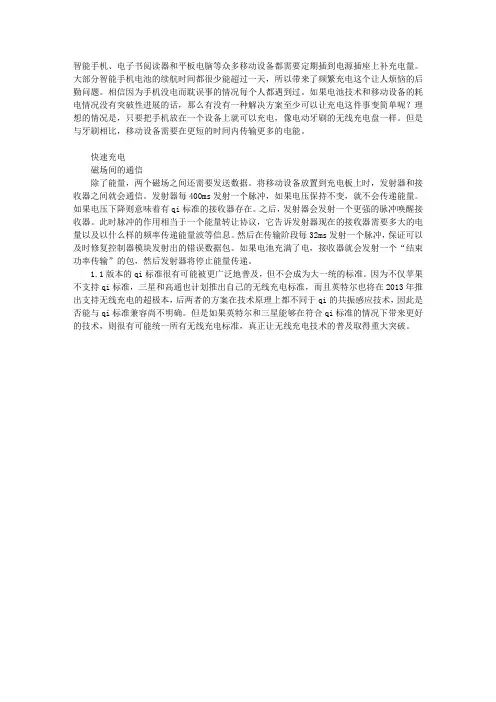
智能手机、电子书阅读器和平板电脑等众多移动设备都需要定期插到电源插座上补充电量。
大部分智能手机电池的续航时间都很少能超过一天,所以带来了频繁充电这个让人烦恼的后勤问题。
相信因为手机没电而耽误事的情况每个人都遇到过。
如果电池技术和移动设备的耗电情况没有突破性进展的话,那么有没有一种解决方案至少可以让充电这件事变简单呢?理想的情况是,只要把手机放在一个设备上就可以充电,像电动牙刷的无线充电盘一样。
但是与牙刷相比,移动设备需要在更短的时间内传输更多的电能。
快速充电磁场间的通信除了能量,两个磁场之间还需要发送数据。
将移动设备放置到充电板上时,发射器和接收器之间就会通信。
发射器每400ms发射一个脉冲,如果电压保持不变,就不会传递能量。
如果电压下降则意味着有qi标准的接收器存在。
之后,发射器会发射一个更强的脉冲唤醒接收器。
此时脉冲的作用相当于一个能量转让协议,它告诉发射器现在的接收器需要多大的电量以及以什么样的频率传递能量波等信息。
然后在传输阶段每32ms发射一个脉冲,保证可以及时修复控制器模块发射出的错误数据包。
如果电池充满了电,接收器就会发射一个“结束功率传输”的包,然后发射器将停止能量传递。
1.1版本的qi标准很有可能被更广泛地普及,但不会成为大一统的标准。
因为不仅苹果不支持qi标准,三星和高通也计划推出自己的无线充电标准,而且英特尔也将在2013年推出支持无线充电的超极本,后两者的方案在技术原理上都不同于qi的共振感应技术,因此是否能与qi标准兼容尚不明确。
但是如果英特尔和三星能够在符合qi标准的情况下带来更好的技术,则很有可能统一所有无线充电标准,真正让无线充电技术的普及取得重大突破。

qi无线充电标准引言无线充电是一种通过电磁感应将能量传输到充电设备的无线充电技术。
Qi无线充电标准是由无线功率联盟(Wireless Power Consortium)制定的一种行业标准,旨在推动无线充电技术的发展和普及。
该标准规定了无线充电设备的通信协议、功率传输规范、兼容性要求等内容,为无线充电设备的互操作性提供了保障。
1. Qi无线充电标准的背景1.1 无线充电的发展历程传统的充电方式主要是通过有线充电,需要使用充电器和数据线将电源连接到充电设备上。
然而,有线充电存在一些不便之处,比如需要携带充电器和连接线,容易损坏或丢失。
因此,无线充电技术应运而生,为用户提供了更加便利和简单的充电方式。
1.2 Qi无线充电标准的意义Qi无线充电标准的推出,标志着无线充电技术的正式进入商业化阶段。
该标准不仅可以提高无线充电设备的互操作性,还可以降低充电设备的制造成本,推动无线充电技术的普及和应用。
同时,Qi无线充电标准还为无线充电设备的安全性和性能提供了基准,确保用户获得高效、安全和可靠的充电体验。
2. Qi无线充电标准的主要内容2.1 通信协议Qi无线充电标准规定了充电设备之间的通信协议,包括设备的识别、认证、数据传输等方面。
充电设备可以通过通信协议实现互联互通,确保正确地进行充电操作。
2.2 功率传输规范Qi无线充电标准定义了功率传输的规范,包括输出功率、传输距离等参数。
根据标准的要求,充电设备可以提供不同功率的充电能量,以满足不同设备的充电需求。
2.3 兼容性要求Qi无线充电标准要求充电设备具备一定的兼容性,能够与符合标准的其他设备进行互联互通。
该标准规定了设备之间的最低兼容性要求,确保不同厂家生产的充电设备可以互相充电。
3. Qi无线充电标准的优势3.1 方便易用无线充电可以使用户摆脱传统充电方式的束缚,不再需要携带和连接充电器。
用户只需将设备放在充电基座上,即可开始充电,方便快捷。
3.2 安全可靠Qi无线充电标准对充电设备的安全性和性能提出了要求,确保用户获得安全、可靠的充电体验。
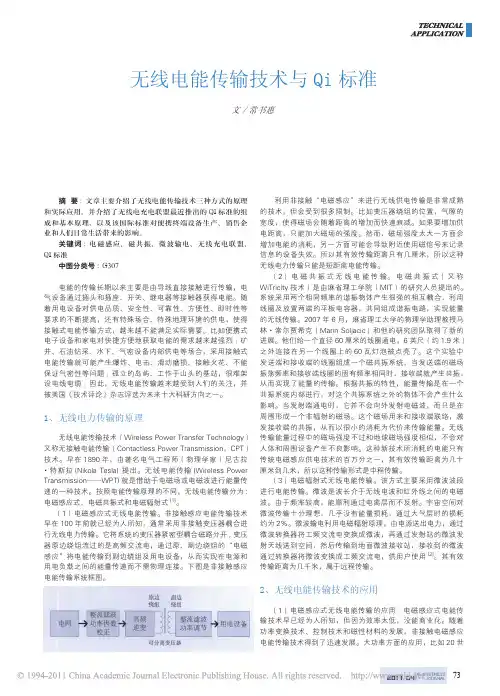
摘 要:文章主要介绍了无线电能传输技术三种方式的原理和实际应用。
并介绍了无线电充电联盟最近推出的Qi标准的组成和基本原理,以及该国际标准对便携终端设备生产、销售企业和人们日常生活带来的影响。
关键词:电磁感应、磁共振、微波输电、无线充电联盟、Qi标准中图分类号:G307电能的传输长期以来主要是由导线直接接触进行传输,电气设备通过插头和插座、开关、继电器等接触器获得电能。
随着用电设备对供电品质、安全性、可靠性、方便性、即时性等要求的不断提高,还有特殊场合、特殊地理环境的供电,使得接触式电能传输方式,越来越不能满足实际需要。
比如便携式电子设备和家电对快捷方便地获取电能的需求越来越强烈;矿井、石油钻采、水下、气密设备内部供电等场合,采用接触式电能传输就可能产生爆炸、电击、滑动磨损、接触火花、不能保证气密性等问题;孤立的岛屿、工作于山头的基站,很难架设电线电缆;因此,无线电能传输越来越受到人们的关注,并被美国《技术评论》杂志评选为未来十大科研方向之一。
1、无线电力传输的原理无线电能传输技术(Wireless Power Transfer Technology)又称无接触电能传输(Contactless Power Transmission,CPT)技术。
早在1890年,由著名电气工程师(物理学家)尼古拉·特斯拉(Nikola Tesla) 提出。
无线电能传输(Wireless Power Transmission——WPT)就是借助于电磁场或电磁波进行能量传递的一种技术。
按照电能传输原理的不同,无线电能传输分为:电磁感应式、电磁共振式和电磁辐射式[1]。
(1)电磁感应式无线电能传输。
非接触感应电能传输技术早在100年前就已经为人所知,通常采用非接触变压器耦合进行无线电力传输。
它将系统的变压器紧密型耦合磁路分开,变压器原边绕组流过的是高频交流电,通过原、副边绕组的“电磁感应”将电能传输到副边绕组及用电设备,从而实现在电源和用电负载之间的能量传递而不需物理连接。

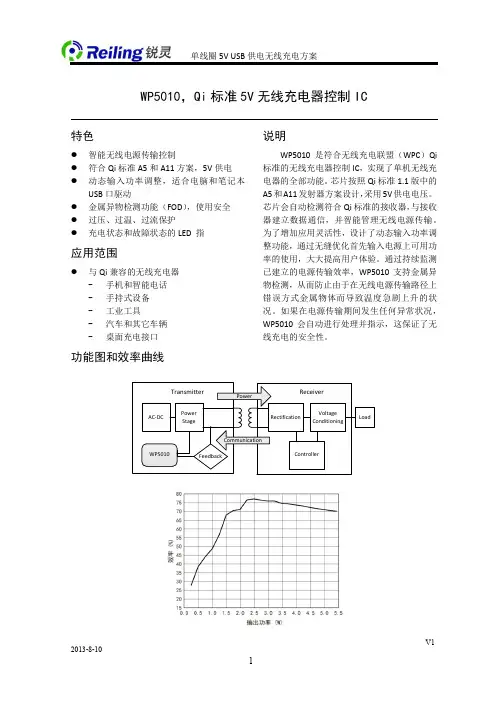
WP5010,Qi标准5V无线充电器控制IC特色●智能无线电源传输控制●符合Qi标准A5和A11方案,5V供电●动态输入功率调整,适合电脑和笔记本USB口驱动●金属异物检测功能(FOD),使用安全●过压、过温、过流保护●充电状态和故障状态的LED 指应用范围●与Qi兼容的无线充电器-手机和智能电话-手持式设备-工业工具-汽车和其它车辆-桌面充电接口说明WP5010是符合无线充电联盟(WPC)Qi 标准的无线充电器控制IC,实现了单机无线充电器的全部功能。
芯片按照Qi标准1.1版中的A5和A11发射器方案设计,采用5V供电电压。
芯片会自动检测符合Qi标准的接收器,与接收器建立数据通信,并智能管理无线电源传输。
为了增加应用灵活性,设计了动态输入功率调整功能,通过无缝优化首先输入电源上可用功率的使用,大大提高用户体验。
通过持续监测已建立的电源传输效率,WP5010支持金属异物检测,从而防止由于在无线电源传输路径上错误方式金属物体而导致温度急剧上升的状况。
如果在电源传输期间发生任何异常状况,WP5010会自动进行处理并指示,这保证了无线充电的安全性。
功能图和效率曲线电气特性极限参数直流特性(TA=25℃)器件描述功能框图COM1COM2VSNS ISNS TSNS BUZZERPWM1PWM2LEDT1T2ENHB引脚说明No. Name I/O Description应用说明线圈和匹配电容发射器线圈和匹配电容Qi标准已有明确规定,必须按照规定选择线圈和匹配电容,不可随意更改。
WP5010适用于A5和A11方案,请参照Qi标准文档选择所需要的线圈。
匹配电容对发射器的正常工作至关重要。
线圈的匹配电容应为400±5%nF,电容耐压值应不低于50V。
应选择C0G/NPO或相当材质的电容,不推荐使用X7R材质的电容。
由于400nF并不是标准容值,可采用4个100nF电容或者1个180nF和1个220nF电容并联。
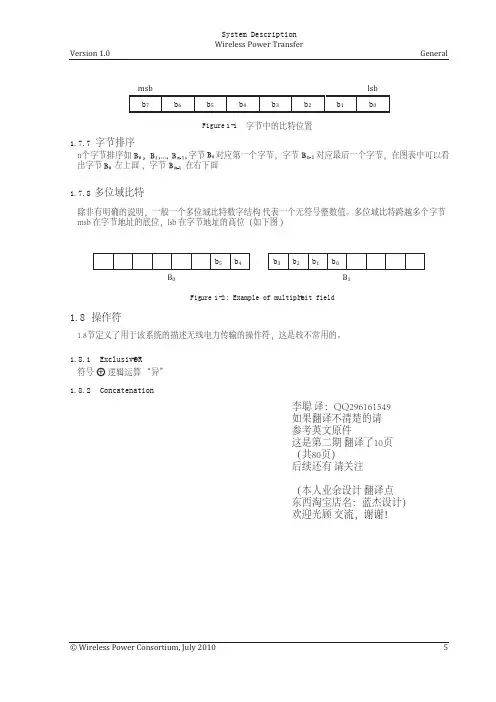
系统的描述,无线通信电源转换低功率第一部分:接口定义版本1.0,2010年7月版权该系统描述无线功率传输是出版的力量,无线通信联合体采用无线力量联盟与ConvenientPower有限公司密切合作,富尔顿创新公司、国家半导体公司,诺基亚公司,奥林匹斯成像公司、研究、限制、飞利浦、三洋电子公司。
深圳桑菲消费通信有限公司。
菲德州仪器有限公司,保留所有能量。
复制在全部或部分地是被禁止的明示和优先的书面允许的无线能力联盟。
免责声明本网站内所包含的信息是正确之日出版。
然而,无线的力量,也ConvenientPower协会有限公司,富尔顿创新公司和国家诺基亚公司半导体公司、企业、科研、奥林匹斯成像议案有限公司、飞利浦、三洋电子公司。
深圳桑菲消费通信有限公司。
德州仪器有限公司,也将承担任何损失,包括间接的或间接的,从使用这个系统描述无线功率传输或依据。
本文件的准确性。
分类在这个文件中所包含的信息是机密。
注意为进一步解释,这份文件的内容,或在任何可察觉不一致或模棱两可的解释,或为任何资讯相关的专利许可程序,请联系:info@。
1 综述1.1范围,我的系统体积的无线功率传输由描述下列文件:第一部分:接口定义。
第二部分:性能要求。
第三部份:测试的依从。
本文档定义了的交互界面和供电功率发射机接收器。
1.2主要特征无触点电力传输的方法,从一个基站移动设备,它是基于近场磁感应线圈之间。
转移的功率,大约5 W采用适当的二次卷(典型的外部大约40毫米)的尺寸。
操作频率范围:110-205 HZ之间。
支持两种方法在移动设备上放置在基站的表面。
帮助用户指引正确位置的移动设备在表面形成一层。
通过基站,提供一个或几个固定位置的表面。
任意位置可以免费定位的移动设备上表面形成一层可提供电力基站位置,通过任何表面。
一个简单的通信协议使移动设备能够充分的控制能力转让。
可观的设计系统的灵活性为整合成一个移动的装置。
非常低的备用电源(执行),可依赖安装。
QI wireless charger product name pictureThe 7 coil QIwirelesschargerBoth mobile andQI wirelesschargerBoth mobile andQI wirelesschargersingle coil QI wireless chargersingle coil QI wireless charger(cost down) IPHONE 4/4S QI wireless receiverIPHONE 5 QI wireless receivercolorful Ringlight QIwirelesschargerQI wirelesschargingreceiverfor SamsungGALAXYS3/NOTE2/S4驰越科技有限公司 杨岳群 18820rgerspecSuitable for standard:Compatible with QI standardV1.0/1.1 power:9V/150MA DCoutput voltage:5Voutput:20-1000mAoperating temperature:0-40℃charge efficiency:65%~80%charging range is over 12 timesthe size of single coil, don'tneed careful alignmentSuitable for standard:Compatible with QI standardV1.0/1.1 portablepower: 6000MAHinput voltage:DC5V 2Aoutput:20-1000mAoperating temperature:0-40℃charge efficiency:wired 90%,wireless 60-65%when wireless charging, no needexternal cableSuitable for standard:Compatible with QI standardV1.0/1.1 portablepower: 1000MAHinput voltage:DC5V 2Aoutput:20-1000mAoperating temperature:0-40℃charge efficiency:wired 90%,wireless 60-65%when wireless charging, no needexternal cableinterface: USB MICROinput voltage: DC5V 2A input:500-2000mALoad driving:≤5W efficiency:≤75%operating temperature:0-40℃Humidity range:45-85%RH Have a sound to remind interface: USB MICROinput voltage: DC5V 2A input:500-2000mALoad driving:≤5W efficiency:≤71%operating temperature:0-40℃Humidity range:45-85%RH Have a sound to remind Suitable for standard: Compatible with QI standardV1.0/1.1charging distance: 2-5MM output voltage: 5Voutput current:500mA operating temperature:0-40℃Suitable for standard: Compatible with QI standardV1.0/1.1charging distance: 2-5MM output voltage: 5Voutput current:500mA operating temperature:0-40℃interface: USB MICROinput voltage: DC5V 2Ainput:500-2000mALoad driving:≤5Wefficiency:≤75%operating temperature:0-40℃Humidity range:45-85%RHColorful ring lamp,Theantiskid design and the human voiceMax output power:DC5V800MACharging frequency:100-200Khz Wireless distance:5mmWeight:10gproduct size: 60.5*50*1.3mmefficiency:≤75%charging voltage:5Vcharging current:500-1000MA 188********。
qi无线充电标准简介无线充电是指通过无线电波或者磁场将电能传输到移动设备的一种充电方式。
qi无线充电标准是一种广泛应用于智能手机、无线耳机等设备的无线充电技术标准。
本文将介绍qi无线充电标准的基本原理、技术规范以及使用注意事项。
原理qi无线充电标准是由Wireless Power Consortium(WPC)制定的一项技术标准,旨在实现无线充电设备之间的互操作性。
qi无线充电采用感应耦合的方式,通过将电器设备放置在充电垫上,利用电磁感应将电能传输到设备,实现无线充电的目的。
技术规范qi无线充电器qi无线充电器是指符合qi无线充电标准的充电设备。
根据技术规范,qi无线充电器需要满足以下要求:•输出功率:qi无线充电器的输出功率通常在5瓦到15瓦之间,可以根据设备的需求进行调整。
•充电效率:qi无线充电器的充电效率应达到最佳状态,提供高效、稳定的充电体验。
•多设备兼容:qi无线充电器应支持同时给多个设备进行充电,并能够自适应不同设备的需求。
qi无线充电设备qi无线充电设备是指符合qi无线充电标准的移动设备,如智能手机、无线耳机等。
qi无线充电设备需要满足以下要求:•接收功率:qi无线充电设备的接收功率应与充电器的输出功率匹配,在充电时能够高效地接收电能。
•安全性:qi无线充电设备应符合相关的安全规范,避免过热、过充等安全问题。
•互操作性:qi无线充电设备应能与符合qi无线充电标准的充电器进行充电,实现互操作性。
qi无线充电模块qi无线充电模块是指集成qi无线充电技术的电子模块,可以嵌入到各种设备中实现无线充电功能。
qi无线充电模块需要满足以下要求:•尺寸适配:qi无线充电模块应具有适合嵌入设备的尺寸和形状。
•电能传输效率:qi无线充电模块应具有高效的电能传输效率,提供稳定的充电体验。
•兼容性:qi无线充电模块应与符合qi无线充电标准的充电器和设备兼容,实现互操作性。
使用注意事项在使用qi无线充电设备时,需要注意以下事项:•只使用符合qi无线充电标准的充电器和设备,以确保充电的效率和安全性。
System Description Wireless Power TransferVolume I: Low Power Part 1: Interface DefinitionVersion 1.0July 2010Wireless Power TransferVersion 1.0System DescriptionWireless Power TransferVolume I: Low PowerPart 1: Interface DefinitionVersion 1.0July 2010Wireless Power TransferVersion 1.0 COPYRIGHTThis System Description Wireless Power Transfer is published by the Wireless Power Consortium, and has been prepared by the Wireless Power Consortium in close co-operation with ConvenientPower Ltd., Fulton Innovation LLC, National Semiconductor Corporation, Nokia Corporation, Olympus Imaging Corporation, Research In Motion, Limited, Royal Philips Electronics, Sanyo Electric Co. Ltd., Shenzhen Sang Fei Consumer Communications Co. Ltd., and Texas Instruments Inc.. All rights are reserved. Reproduction in whole or in part is prohibited without express and prior written permission of the Wireless Power Consortium.DISCLAIMERThe information contained herein is believed to be accurate as of the date of publication. However, neither the Wireless Power Consortium, nor ConvenientPower Ltd., nor Fulton Innovation LLC, nor National Semiconductor Corporation, nor Nokia Corporation, nor Olympus Imaging Corporation, nor Research In Motion Limited, nor Royal Philips Electronics, nor Sanyo Electric Co. Ltd., nor Shenzhen Sang Fei Consumer Communications Co. Ltd., nor Texas Instruments Inc. will be liable for any damages, including indirect or consequential, from use of this System Description Wireless Power Transfer or reliance on the accuracy of this document.CLASSIFICATIONThe information contained in this document is marked as confidential.NOTICEFor any further explanation of the contents of this document, or in case of any perceived inconsistency or ambiguity of interpretation, or for any information regarding the associated patent license program, please contact: info@.Version 1.0 Table of ContentsTable of Contents1General (1)1.1Scope (1)1.2Main features (1)1.3Conformance and references (1)1.4Definitions (2)1.5Acronyms (3)1.6Symbols (3)1.7Conventions (4)1.7.1Cross references (4)1.7.2Informative text (4)1.7.3Terms in capitals (4)1.7.4Notation of numbers (4)1.7.5Units of physical quantities (4)1.7.6Bit ordering in a byte (4)1.7.7Byte numbering (5)1.7.8Multiple-bit Fields (5)1.8Operators (5)1.8.1Exclusive-OR (5)1.8.2Concatenation (5)2System Overview (Informative) (7)3Basic Power Transmitter Designs (11)3.1Introduction (11)3.2Power Transmitter designs that are based on a single Primary Coil (11)3.2.1Power Transmitter design A1 (11)3.2.2Power Transmitter design A2 (16)3.3Power Transmitter designs that are based on an array of Primary Coils (20)3.3.1Power Transmitter design B1 (20)3.3.2Power Transmitter design B2 (26)4Power Receiver Design Requirements (29)4.1Introduction (29)4.2Power Receiver design requirements (30)4.2.1Mechanical requirements (30)4.2.2Electrical requirements (31)5System Control (35)5.1Introduction (35)5.2Power Transmitter perspective (38)5.2.1Ping phase (38)5.2.2Identification & configuration phase (39)5.2.3Power transfer phase (42)5.3Power Receiver perspective (46)5.3.1Selection phase (46)5.3.2Ping phase (47)Table of Contents Version 1.05.3.3Identification & configuration phase (47)5.3.4Power transfer phase (48)6Communications Interface (51)6.1Introduction (51)6.2Physical and data link layers (51)6.2.1Modulation scheme (51)6.2.2Bit encoding scheme (52)6.2.3Byte encoding scheme (52)6.2.4Packet structure (52)6.3Logical layer (55)6.3.1Signal Strength Packet (0x01) (55)6.3.2End Power Transfer Packet (0x02) (56)6.3.3Control Error Packet (0x03) (57)6.3.4Rectified Power Packet (0x04) (57)6.3.5Charge Status Packet (0x05) (57)6.3.6Power Control Hold-off Packet (0x06) (57)6.3.7Configuration Packet (0x51) (58)6.3.8Identification Packet (0x71) (58)6.3.9Extended Identification Packet (0x81) (60)Annex A Example Power Receiver Designs (Informative) (61)A.1Power Receiver example 1 (61)A.1.1Mechanical details (61)A.1.2Electrical details (62)A.2Power Receiver example 2 (64)A.2.1Mechanical details (64)A.2.2Electrical details (65)Annex B Object Detection (Informative) (67)B.1Resonance shift (67)B.2Capacitance change (68)Annex C Power Receiver Localization (Informative) (69)C.1Guided Positioning (69)C.2Primary Coil array based Free Positioning (69)C.2.1 A single Power Receiver covering multiple Primary Cells (69)C.2.2Two Power Receivers covering two adjacent Primary Cells (70)C.2.3Two Power Receivers covering a single Primary Cell (70)C.3Moving Primary Coil based Free Positioning (71)Annex D Metal Object Detection (Informative) (73)Version 1.0 Table of Contents List of FiguresFigure 1-1: Bit positions in a byte (5)Figure 1-2: Example of multiple-bit field (5)Figure 2-1: Basic system overview (8)Figure 3-1: Functional block diagram of Power Transmitter design A1 (11)Figure 3-2: Primary Coil of Power Transmitter design A1 (12)Figure 3-3: Primary Coil assembly of Power Transmitter design A1 (13)Figure 3-4: Electrical diagram (outline) of Power Transmitter design A1 (14)Figure 3-5: Functional block diagram of Power Transmitter design A2 (16)Figure 3-6: Primary Coil of Power Transmitter design A2 (17)Figure 3-7: Primary Coil assembly of Power Transmitter design A2 (18)Figure 3-8: Electrical diagram (outline) of Power Transmitter design A2 (19)Figure 3-9: Functional block diagram of Power Transmitter design B1 (20)Figure 3-10: Primary Coil array of Power Transmitter design B1 (21)Figure 3-11: Primary Coil array assembly of Power Transmitter design B1 (22)Figure 3-12: Electrical diagram (outline) of Power Transmitter design B1 (23)Figure 3-13: Multiple type B1 Power Transmitters sharing a multiplexer and Primary Coil array (25)Figure 3-14: Primary Coil array of Power Transmitter design B2 (27)Figure 4-1: Example functional block diagram of a Power Receiver (29)Figure 4-2: Secondary Coil assembly (30)Figure 4-3: Dual resonant circuit of a Power Receiver (31)Figure 4-4: Characterization of resonant frequencies (32)Figure 5-1: Power transfer phases (35)Figure 5-2: Power transfer control loop (37)Figure 5-3: Power Transmitter timing in the ping phase (39)Figure 5-4: Power Transmitter timing in the identification & configuration phase (41)Figure 5-5: Power Transmitter timing in the power transfer phase (43)Figure 5-6: PID control algorithm (44)Figure 5-7: Power Receiver timing in the selection phase (47)Figure 5-8: Power Receiver timing in the ping phase (47)Figure 5-9: Power Receiver timing in the identification & configuration phase (48)Figure 5-10: Power Receiver timing in the power transfer phase (49)Figure 6-1: Amplitude modulation of the Power Signal (51)Figure 6-2: Example of the differential bi-phase encoding (52)Figure 6-3: Example of the asynchronous serial format (52)Figure 6-4: Packet format (53)Figure A-1: Secondary Coil of Power Receiver example 1 (61)Figure A-2: Secondary Coil and Shielding assembly of Power Receiver example 1 (62)Figure A-3: Electrical details of Power Receiver example 1 (62)Figure A-4: Li-ion battery charging profile (63)Figure A-5: Secondary Coil of Power Receiver example 2 (64)Figure A-6: Secondary Coil and Shielding assembly of Power Receiver example 2 (65)Figure A-7: Electrical details of Power Receiver example 2 (66)Figure B-1: Analog ping based on a resonance shift (67)Figure C-1: Single Power Receiver covering multiple Primary Cells (70)Figure C-2: Two Power Receivers covering two adjacent Primary Cells (70)Figure C-3: Two Power Receivers covering a single Primary Cell (71)Figure C-4: Detection Coil (72)Table of Contents Version 1.0 List of TablesTable 3-1: Primary Coil parameters of Power Transmitter design A1 (12)Table 3-2: PID parameters for Operating Frequency control (14)Table 3-3: Operating Frequency dependent scaling factor (14)Table 3-4: PID parameters for duty cycle control (15)Table 3-5: Primary Coil parameters of Power Transmitter design A2 (17)Table 3-6: PID parameters for voltage control (19)Table 3-7: Primary Coil array parameters of Power Transmitter design B1 (22)Table 3-8: PID parameters for voltage control (24)Table 3-9: Primary Coil array parameters of Power Transmitter design B2 (26)Table 5-1: Power Transmitter timing in the ping phase (38)Table 5-2: Power Transmitter timing in the identification & configuration phase (41)Table 5-3: Power control hold-off time (41)Table 5-4: Power Transmitter timing in the power transfer phase (44)Table 5-5: Power Receiver timing in any phase (46)Table 5-6: Power Receiver timing in the selection phase (47)Table 5-7: Power Receiver timing in the identification & configuration phase (48)Table 5-8: Power Receiver timing in the power transfer phase (49)Table 6-1: Amplitude modulation of the Power Signal (52)Table 6-2: Message size (53)Table 6-3: Packet types (54)Table 6-4: Signal Strength (55)Table 6-5: End Power Transfer (56)Table 6-6: End Power Transfer values (56)Table 6-7: Control Error (57)Table 6-8: Rectified Power (57)Table 6-9: Charge Status (57)Table 6-10: Power control hold-off (58)Table 6-11: Configuration (58)Table 6-12: Identification (59)Table 6-13: Extended Identification (60)Table A-1: Secondary Coil parameters of Power Receiver example 1 (61)Table A-2: Parameters of the Secondary Coil of Power Receiver example 2 (64)Table B-1: Analog ping based on a resonance shift (67)Version 1.0 General1General1.1ScopeVolume I of the System Description Wireless Power Transfer consists of the following documents: ∙Part 1, Interface Definition.∙Part 2, Performance Requirements.∙Part 3, Compliance Testing.This document defines the interface between a Power Transmitter and a Power Receiver.1.2Main features∙ A method of contactless power transfer from a Base Station to a Mobile Device, which is based on near field magnetic induction between coils.∙Transfer of around 5 W of power, using an appropriate Secondary Coil (having a typical outer dimension of around 40 mm).∙Operation at frequencies in the 110…205 kHz range.∙Support for two methods of placing the Mobile Device on the surface of the Base Station: o Guided Positioning helps a user to properly place the Mobile Device on the surface of a Base Station that provides power through a single or a few fixed locations of that surface.o Free Positioning enables arbitrary placement of the Mobile Device on the surface of a Base Station that can provide power through any location of that surface.∙ A simple communications protocol enabling the Mobile Device to take full control of the power transfer.∙Considerable design flexibility for integration of the system into a Mobile Device.∙Very low stand-by power achievable (implementation dependent).1.3Conformance and referencesAll specifications in this document are mandatory, unless specifically indicated as recommended or optional or informative. To avoid any doubt, the word “shall”indicates a mandatory behavior of the specified component, i.e. it is a violation of this System Description Wireless Power Transfer if the specified component does not exhibit the behavior as defined. In addition, the word “should” indicates a recommended behavior of the specified component, i.e. it is not a violation of this System Description Wireless Power Transfer if the specified component has valid reasons to deviate from the defined behavior. And finally, the word “may” indicates an optional behavior of the specified component, i.e. it is up to the specified component whether to exhibit the defined behavior (without deviating there from) or not.In addition to the specifications provided in this document, product implementations shall also conform to the specifications provided in the System Descriptions listed below. Moreover, the relevant parts of the International Standards listed below shall apply as well. If multiple revisions exist of any System Description or International Standard listed below, the applicable revision is the one that was most recently published at the release date of this document.[Part 2] System Description Wireless Power Transfer, Volume I, Part 2, Performance Requirements.[Part 3] System Description Wireless Power Transfer, Volume I, Part 3, Compliance Testing.[PRMC] Power Receiver Manufacturer Codes, Wireless Power Consortium.General Version 1.0 [SI] The International System of Units (SI), Bureau International des Poids etMesures.1.4DefinitionsActive Area The part of the Interface Surface of a Base Station respectively Mobile Devicethrough which a sufficiently high magnetic flux penetrates when the BaseStation is providing power to the Mobile Device.Base Station A device that is able to provide near field inductive power as specified in thisSystem Description Wireless Power Transfer. A Base Station carries a logo tovisually indicate to a user that the Base Station complies with this SystemDescription Wireless Power Transfer.Communications and Control UnitThe functional part of a Power Transmitter respectively Power Receiver thatcontrols the power transfer. (Informative) Implementation-wise, theCommunications and Control Unit may be distributed over multiple subsystems ofthe Base Station respectively Mobile Device.Control Point The combination of voltage and current provided at the output of the PowerReceiver, and other parameters that are specific to a particular Power Receiverimplementation.Detection Unit The functional part of a Power Transmitter that detects the presence of a PowerReceiver on the Interface Surface.Digital Ping The application of a Power Signal in order to detect and identify a PowerReceiver.Free Positioning A method of positioning a Mobile Device on the Interface Surface of a BaseStation that does not require the user to align the Active Area of the MobileDevice to the Active Area of the Base Station.Guided Positioning A method of positioning a Mobile Device on the Interface Surface of a BaseStation that provides the user with feedback to properly align the Active Area ofthe Mobile Device to the Active Area of the Base Station.Interface Surface A flat part of the surface of a Base Station respectively Mobile Device that isclosest to the Primary Coil(s) respectively Secondary Coil.Mobile Device A device that is able to consume near field inductive power as specified in thisSystem Description Wireless Power Transfer. A Mobile Device carries a logo tovisually indicate to a user that the Mobile Device complies with this SystemDescription Wireless Power Transfer.Operating Frequency The oscillation frequency of the Power Signal.Operating Point The combination of the frequency, duty cycle and amplitude of the voltage thatis applied to the Primary Cell.Packet A data structure that the Power Receiver uses to communicate a message to thePower Transmitter. A Packet consists of a preamble, a header byte, a message,and a checksum. A Packet is named after the kind of message that it contains. Power Conversion Unit The functional part of a Power Transmitter that converts electrical energy to aPower Signal.Power Pick-up Unit The functional part of a Power Receiver that converts a Power Signal toelectrical energy.Power Receiver The subsystem of a Mobile Device that acquires near field inductive power andcontrols its availability at its output, as defined in this System DescriptionWireless Power Transfer. For this purpose, the Power Receiver communicatesits power requirements to the Power Transmitter.Version 1.0 General Power Signal The oscillating magnetic flux that is enclosed by a Primary Cell and possibly a Secondary Coil.Power Transfer Contract A set of boundary conditions on the parameters that characterize the power transfer from a Power Transmitter to a Power Receiver. Violation of any ofthese boundary conditions causes the power transfer to abort.Power Transmitter The subsystem of a Base Station that generates near field inductive power and controls its transfer to a Power Receiver, as defined in this System DescriptionWireless Power Transfer.Primary Cell A single Primary Coil or a combination of Primary Coils that are used to providea sufficiently high magnetic flux through the Active Area.Primary Coil A component of a Power Transmitter that converts electric current to magnetic flux.Secondary Coil The component of a Power Receiver that converts magnetic flux to electromotive force.Shielding A component in the Power Transmitter respectively Power Receiver that restricts magnetic fields to the appropriate parts of the Base Stationrespectively Mobile Device.1.5AcronymsAC Alternating CurrentAWG American Wire GaugeDC Direct Currentlsb least significant bitmsb most significant bitN.A. Not ApplicablePID Proportional Integral DifferentialRMS Root Mean SquareUART Universal Asynchronous Receiver Transmitter1.6SymbolsC d Capacitance parallel to the Secondary Coil [nF]C m Capacitance in the impedance matching network [nF]Capacitance in series with the Primary Coil [nF]C S Capacitance in series with the Secondary Coil [nF]Distance between a coil and its Shielding [mm]Distance between a coil and the Interface Surface [mm]Communications bit rate [kHz]Resonant detection frequency [kHz]Operating Frequency [kHz]Secondary resonance frequency [kHz]Primary Coil current modulation depth [mA]Power Receiver output current [mA]Primary Coil current [mA]L m Inductance in the impedance matching network [μH]General Version 1.0Primary Coil self inductance [μH]Secondary Coil self inductance (Mobile Device away from Base Station) [μH]Secondary Coil self inductance (Mobile Device on top of Base Station) [μH]Total amount of power received through the Interface Surface [W]Total amount of power transmitted through the Interface Surface [W]Power Control Hold-off Time [ms]Communications clock period [μs]Maximum transition time of the communications [μs]Rectified voltage [V]Power Receiver output voltage [V]1.7ConventionsThis Section 1.7 defines the notations and conventions used in this System Description Wireless Power Transfer.1.7.1Cross referencesUnless indicated otherwise, cross references to Sections in either this document or documents listed in Section 1.3, refer to the referenced Section as well as the sub Sections contained therein.1.7.2Informative textWith the exception of Sections that are marked as informative, all informative text is set in italics.1.7.3Terms in capitalsAll terms that start with a capital are defined in Section 1.4. As an exception to this rule, Packet names and fields are defined in Section 6.3.1.7.4Notation of numbersReal numbers are represented using the digits 0 to 9, a decimal point, and optionally an exponential part. In addition, a positive and/or negative tolerance may follow a real number. Real numbers that do not include an explicit tolerance, have a tolerance of half the least significant digit that is specified. (Informative) For example, a specified value of comprises the range from 1.21 through 1.24; a specified value of comprises the range from 1.23 through 1.24; a specified value of comprises the range from 1.21 through 1.23; a specified value of 1.23 comprises the range from 1.225 through 1.234999…; and a specified value of comprises the range from 1.107 through 1.353. Integer numbers in decimal notation are represented using the digits 0 to 9.Integer numbers in hexadecimal notation are represented using the hexadecimal digits 0 to 9 and A to F, and are preceded by “0x” (unless explicitly indicated otherwise).Single bit values are represented using the words ZERO and ONE.Integer numbers in binary notation and bit patterns are represented using sequences of the digits 0 and 1that are enclosed in single quotes (‘’). In a sequence of n bits, the most significant bit (msb) is bit b n–1 and the least significant bit (lsb) is bit b0; the most significant bit is shown on the left-hand side.1.7.5Units of physical quantitiesPhysical quantities are expressed in units of the International System of Units [SI].1.7.6Bit ordering in a byteThe graphical representation of a byte is such that the msb is on the left, and the lsb is on the right. Figure 1-1 defines the bit positions in a byte.Version 1.0 General msb lsbFigure 1-1: Bit positions in a byte1.7.7Byte numberingThe bytes in a sequence of n bytes are referred to as B0, B1, …, B n–1. Byte B0 corresponds to the first byte in the sequence; byte B n–1 corresponds to the last byte in the sequence. The graphical representation of a byte sequence is such that B0 is at the upper left-hand side, and byte B n–1 is at the lower right-hand side. 1.7.8Multiple-bit FieldsUnless indicated otherwise, a multiple bit field in a data structure represents an unsigned integer value. In a multiple-bit field that spans multiple bytes, the msb of the multiple-bit field is located in the byte with the lowest address, and the lsb of the multiple-bit field is located in the byte with the highest address. (Informative) Figure 1-2 provides an example of a 6-bit field that spans two bytes.B0B1Figure 1-2: Example of multiple-bit field1.8OperatorsThis Section 1.8 defines the operators used in this System Description Wireless Power Transfer, which are less commonly used. The commonly used operators have their usual meaning.1.8.1Exclusive-ORThe symbol ‘ ’ represents the exclusive-OR operation.1.8.2ConcatenationThe symbol ‘||’ represents concatenation of two bit strings. In the resulting concatenated bit string, the msb of the right-hand side operand directly follows the lsb of the left-hand side operand.General Version 1.0This page is intentionally left blank.Version 1.0 System Overview (Informative)2System Overview (Informative)Operation of devices that comply with this System Description Wireless Power Transfer relies on magnetic induction between planar coils. Two kinds of devices are distinguished, namely devices that provide wireless power—referred to as Base Stations—and devices that consume wireless power—referred to as Mobile Devices. Power transfer always takes place from a Base Station to a Mobile Device. For this purpose, a Base Station contains a subsystem—referred to as a Power Transmitter—that comprises a Primary Coil,1 and a Mobile Device contains a subsystem—referred to as a Power Receiver—comprises a Secondary Coil. In fact, the Primary Coil and Secondary Coil form the two halves of a coreless resonant transformer. Appropriate Shielding at the bottom face of the Primary Coil and the top face of the Secondary Coil, as well as the close spacing of the two coils, ensures that power transfer occurs with an acceptable efficiency. In addition, this Shielding minimizes the exposure of users to the magnetic field. Typically, a Base Station has a flat surface—referred to as the Interface Surface—on top of which a user can place one or more Mobile Devices. This ensures that the vertical spacing between Primary Coil and Secondary Coil is sufficiently small. In addition, there are two concepts for horizontal alignment of the Primary Coil and Secondary Coil. In the first concept—referred to as Guided Positioning—the user must actively align the Secondary Coil to the Primary Coil, by placing the Mobile Device on the appropriate location of the Interface Surface. For this purpose, the Mobile Device provides an alignment aid that is appropriate to its size, shape and function. The second concept—referred to as Free Positioning—does not require the active participation in alignment of the Primary Coil and Secondary Coil. One implementation of Free Positioning makes use of an array of Primary Coils to generate a magnetic field at the location of the Secondary Coil only. Another implementation of Free Positioning uses mechanical means to move a single Primary Coil underneath the Secondary Coil.Figure 2-1 illustrates the basic system configuration. As shown, a Power Transmitter comprises two main functional units, namely a Power Conversion Unit and a Communications and Control Unit. The diagram explicitly shows the Primary Coil (array) as the magnetic field generating element of the Power Conversion Unit. The Control and Communications Unit regulates the transferred power to the level that the Power Receiver requests. Also shown in the diagram is that a Base Station may contain multiple Transmitters in order to serve multiple Mobile Devices simultaneously (a Power Transmitter can serve a single Power Receiver at a time only). Finally, the system unit shown in the diagram comprises all other functionality of the Base Station, such as input power provisioning, control of multiple Power Transmitters, and user interfacing.A Power Receiver comprises a Power Pick-up Unit and a Communications and Control Unit. Similar to the Power Conversion Unit of the Transmitter, Figure 2-1 explicitly shows the Secondary Coil as the magnetic field capturing element of the Power Pick-up Unit. A Power Pick-up Unit typically contains a single Secondary Coil only. Moreover, a Mobile Device typically contains a single Power Receiver. The Communications and Control Unit regulates the transferred power to the level that is appropriate for the subsystems connected to the output of the Power Receiver. These subsystems represent the main functionality of the Mobile Device. An important example subsystem is a battery that requires charging. The remainder of this document is structured as follows. Section 3 defines the basic Power Transmitter designs, which come in two basic varieties. The first type of design—type A—is based on a single Primary Coil (either fixed position or moveable). The second type of design—type B—is based on an array of Primary Coils. Note that this version 1.0 of the System Description Wireless Power Transfer, Volume I, Part 1, offers only limited design freedom with respect to actual Power Transmitter implementations. The reason is that Mobile Devices exhibit a much greater variety of design requirements with respect to the Power Receiver than a Base Station does to Power Transmitters—for example, a smart phone has design requirements that differ substantially from those of a wireless headset. Constraining the Power Transmitter therefore enables interoperability with the largest number of mobile devices.1Note that the Primary Coil may be a “virtual coil,” in the sense that an appropriate array of planar coils can generate a magnetic field that is similar to the field that a single coil generates.System Overview (Informative) Version 1.0Figure 2-1: Basic system overviewSection 4 defines the Power Receiver design requirements. In view of the wide variety of Mobile Devices, this set of requirements has been kept to a minimum. In addition to the design requirements, Section 4 is complemented with two example designs in Annex A.Section 5 defines the system control aspects of the power transfer. The interaction between a Power Transmitter and a Power Receiver comprises four phases, namely selection, ping, identification & configuration, and power transfer. In the selection phase, the Power Transmitter attempts to discover and locate objects that are placed on the Interface Surface. In addition, the Power Transmitter attempts to discriminate between Power Receivers and foreign objects and to select a Power Receiver (or object) for power transfer. For this purpose, the Power Transmitter may select an object at random and proceed to the ping phase (and subsequently to the identification & configuration phase) to collect necessary information. Note that if the Power Transmitter does not initiate power transfer to a selected Power Receiver, it should enter a low power stand-by mode of operation.2In the ping phase, the Power Transmitter attempts to discover if an object contains a Power Receiver. In the identification & configuration phase, the Power Transmitter prepares for power transfer to the Power Receiver. For this purpose, the Power Transmitter retrieves relevant information from the Power Receiver. The Power Transmitter combines this information with information that it stores internally to construct a so-called Power Transfer Contract, which comprises various limits on the power transfer. In the power transfer2A definition of such a stand-by mode is outside the scope of this version 1.0 System Description Wireless Power Transfer, Volume I, Part 1. However, [Part 2] provides requirements on the maximum power use of a Power Transmitter when it is not actively providing power to a Power Receiver.。
qi无线充电标准
Qi(发音为“chee”)是无线充电的一种标准。
它是由Wireless Power Consortium(WPC)制定的一种无线充电协议和技术标准。
Qi无线充电标准的目的是为了实现无线充电设备之间的互操作性,使得不同厂商生产的设备能够相互兼容。
Qi标准使用电磁感应原理,通过一个无线充电器(发射器)和一个无线充电设备(接收器)之间的电磁场交互作用,将电能从发射器传输到接收器,实现设备的无线充电。
Qi无线充电标准支持的功率范围从1瓦特到30瓦特,可以为智能手机、平板电脑、智能手表、移动电源等设备提供无线充电功能。
它可以通过电磁感应、谐振耦合或者电磁辐射等方式实现无线充电,具有较高的充电效率和充电速度。
目前,许多主流智能手机厂商如苹果、三星、华为等都支持Qi无线充电标准,用户可以通过方便地将设备放置在支持Qi 标准的充电器上实现无线充电。
Qi标准及无线充电解决方案介绍Qi标准及无线充电解决方案介绍无线充电技术在消费类市场表现出巨大的市场潜力。
在不使用连线的情况下给电子设备充电不但可为便携式设备用户提供一种便利的解决方案,而且还让广大人员能够寻找到更具创新性的问题解决方法。
许多电池供电型便携式设备均能受益于这种技术,从手机到电动汽车不一而足。
电感耦合方法可以实现高效和通用的无线充电。
为了便于使用并且让设计人员和消费者都受益,无线充电联盟 (WPC) 制定出了一种标准,在供电设备(无线发射端,充电站)和用电设备(无线接收端,便携式设备)之间创建了互操作性。
WPC 成立于 2021 年,由亚洲、欧洲和美国的各行业公司组成,其中包括电子设备制造厂商和原始设备制造商 (OEM)。
WPC 标准定义了电感耦合(线圈结构)的类型,以及低功率无线设备所用的通信协议。
在这种标准下工作的任何设备都可以与任何其他 WPC 兼容设备配对。
这种方法的一个重要的好处是其利用这些线圈来实现无线发送端和无线接收端之间的通信。
无线充电 WPC 标准WPC 标准下,无线传输的低功率就是说功耗仅为 0~5W。
达到这一标准范围的系统在两个平面线圈之间使用电感耦合来将电力从无线发送端传输给无线接收端。
两个线圈之间的距离一般为 5mm。
输出电压调节由一个全局数字控制环路负责,这时无线接收端会与无线发送端通信,并要求或多或少的功率。
该通信是一种通过反向散射调制从无线接收端到无线发送端的单向通信。
在反向散射调制中,无线接收端线圈受到负载,从而改变无线发送端的电流消耗。
我们对这些电流变化进行监控,并解调成两个设备协同工作所需的信息。
WPC 标准定义了系统的三个主要方面提供电力的无线发送端、使用电力的无线接收端以及这两种设备之间的通信协议。
下面,我们将详细介绍这三个方面。
无线发送端电力传输方向始终是从无线发送端到无线接收端。
无线发送端的关键电路是用于向无线接收端传输电力的一次线圈、驱动一次线圈的控制单元以及解调一次线圈电压或者电流的通信电路。
v1.0 可编辑可修改QI无线充电标准1概述1.1范围系统描述无线电能传输第1卷包含以下文档:第一部分:接口定义第二部分:性能要求第三部分:兼容性测试该文件定义了一个电能发射器和一个电能接收器之间的接口。
主要特性一种基于线圈之间的近场电磁感应原理,将电能从发射器传输到移动设备(接收器)的非接触式电能传输方法。
通过一个适当的次级线圈(典型尺寸是大约40mm)来传输约5瓦特的电能。
工作频率在110~205KHz之间。
支持两种将移动设备放置于发射器表面的方法:辅助定位方法帮助用户适当地将移动设备放在通过表面上一个或几个固定的位置来传输电能的发射器的表面。
无需定位方法允许移动设备任意放在支持表面任何位置传输能量的发射器表面。
一个简单的允许移动设备完全控制电能传送的通信协议。
相当大的可集成在移动设备上的设计灵活性。
极低的待机功耗(实现需要)。
一致性与参考本文档中的所有规定都是强制性的,除非特别指明是推荐的、可选的或加强说明的。
为避免产生疑问,单词“应”表示指定部分为强制行为,也就是说,如果指定的部分没有所定义的行为,则这就违反了无线电能传输标准。
此外,单词“应该”表示指定部分为推荐行为,也就是说,如果指定的组件有正当理由偏离所定义的行为,则这不是违反了无线电能传输标准的。
最后,单词“可以”表示指定组件的可选行为,也就是说,是否具有所定义的行为(没有偏离)是取决于指定组件。
除本文件所提出的规范外,产品的实现也应符合下面所列出的系统说明所提出的规范。
此外,下列国际标准的相关部分也应遵守。
如果任何系统描述或以下所列出的国际标准存在多个修订版本,以最新版本为准。
[第2部] 无线电能传输系统描述,第I卷,第2部分,性能要求。
[第3 部] 无线电能传输系统描述,第I卷,第3部分,兼容性测试。
[PRMC] 电源接收器制造商代码,无线充电联盟。
[SI] 国际计量制。
定义有效区域:当发射器向移动设备供电时,发射器和接收器各自表面的一部分有足够高的磁场通过的区域。
发射器:在系统描述无线电能传输规范特别说明的能产生近场感应电能的特殊设备。
发射器带有标识,以直观地告知用户本发射器符合系统描述无线电能传输规范。
通信和控制单元:电能发射器和电能接收器上用于控制电能传输的功能单元。
(资料)实施的角度来看,通信和控制单元可以分布在发射器和移动设备的多个子系统中。
控制点:接收器输出端的电压和电流的联合,其他参数要视一个特定的接收器实施而定。
检测单元:用来检测发射器表面接收器的存在的发射器功能模块。
数字码:用来检测和识别电能接收器的电能信号。
免定位:无需用户将移动设备的有效区域与发射器的有效区域对齐的将移动设备放置在发射器接口表面的方法。
制导定位:为用户提供反馈以将移动设备的有效区域与发射器有效区域对齐的将移动设备放置到发射器接口表面的方法。
接口表面:发射器或者接收器上靠初级线圈或者次级线圈最近的表面。
移动设备:无线电能传输标准所规定的能利用近场感应电能的移动设备。
在执行此标准的移动设备的表面应有可见的’LOGO来告知用户这个设备执行的是本标准。
工作频率:电源信号的振荡频率。
工作点:初级线圈电压的频率、占空比、幅值的参数组合。
数据包:接收器用于与发射器通信的数据结构。
数据包包括:序言字节,头字节,消息字节和一个校验码。
数据包由其所含信息的类型得名。
电能转换单元:能将电能转换为电能信号的发射器的功能单元。
电能接收单元:能将电能信号转换为电能的接收器的功能单元。
电能接收器:如无线电能传输标准所述能获取近场感应电能并能控制其输出能力的移动设备的一个子系统。
为了达到这个目的,接收器需要与发射器交换其电能需求信息。
电能信号:包围在初级线圈和可能存在的次级线圈中的振荡磁通。
电能传输协议:一组表征发射器与接收器的电能传输需要的边界条件。
任何不满足条件的冲突都会导致停止电能传输。
电能发射器:本标准描述的基站的子系统,能产生近场感应电能,并能控制与接收器的电能传输。
初级(线圈)单元:一个或者多个用来在有效区域产生有效的高能近场感应电能的线圈的组合。
初级线圈:发射器上用来将电流转化成磁通的元件。
次级线圈:接收器上用来将磁通转换成电能的元件。
屏蔽罩:发射器和接收器上都有元件,用来将磁场限制在发射器与接收器之间。
缩写AC 交流电AWG 美国线规(美国的电线标准,规范中规范的电线型号的线径、绝缘强度等)DC 直流电lsb 最小有效值msb 最大有效值. 空,不适用PID 比例积分差分(控制方法)RMS 均方根UART 通用异步(数据)收发器符号C d次级线圈的并联电容[nF]C m阻抗网络中的匹配电容[nF]C p 初级线圈串联电容[nF]C s次级线圈串联电容[nF]d s线圈与屏蔽罩之间的距离[mm]d z线圈与接口表面的距离[mm]f clk通信频率[kHz]f d 谐振检测频率[kHz]f op工作频率[kHz]f s二次共振频率[kHz]I m初级线圈电流的调制深度[mA]I o接收器输出电流[mA]I p初级线圈电流[mA]L m网络中的匹配电感[uH]L p初级线圈自感[uH]L s次级线圈自感(移动设备远离基站)[uH]L’s次级线圈自感(移动设备在基站上)[uH]P p r从接口收到的总功率[W]P pt从接口发出的总功率[W]T delay功率控制时延[ms]t CLK通信时钟周期[us]t T最大通信转换时间[us]V r整流后电压[V]V o功率接收器输出电压[V]约定第节定义了本系统说明无线电能传输中使用的符号和惯例。
交叉引用除非另有说明,在本文档或第节所列的文件,本章节的交叉引用是指所引用的部分,以及其中包含的子部分。
信息文本除了被标记为信息段,所有的信息文本设置为斜体。
重要条款所有重要条款均在第节中定义。
作为一个例外,数据包的名称和字段的名称在第节中定义。
符号数实数是由数字0到9 ,小数点和可选的任意一个指数部分表示的。
此外,正的或负的公差遵循一个实数。
没有明确公差的实数的公差是指定最低有效位的一半。
(信息)例如指定的值为,那么这个值包括的范围是从至 ; 指定的值为,那么这个值包括的范围是从至 ; 指定的值为,那么这个值包括的范围是从至 ; 指定的值为,那么这个值包括的范围是从至…….; 指定的值为,那么这个值包括的范围是从至。
十进制整数是由数字0到9表示的。
十六进制数是由数字0到9和字母A到F表示的,并且有前缀“0X”(特殊说明除外)。
单个位(一字节有8个位)的值由单词ZERO和ONE表示。
二进制数和位图是由单引号(‘’)内序列的数字0和1表示。
在一个n位的序列,最高有效位是n-1位,最低有效位是0位;高位在低位的左边。
单位物理量物理量均以国际单位系统[SI]的单位为单位。
字节的位序一个字节的图形表示是MSB(最高有效位)在左边,而LSB(最低有效位)在右边。
图1-1定义了一个字节中位的位置。
字节编号由n个字节的序列的字节被称为B0,B1,...,Bn-1。
字节B0对应于该序列中的第一个字节,字节Bn-1对应于该序列中的最后一个字节。
一个字节序列的图形表示是字节B 0是在上部左侧,而字节Bn-1是在较低的右手侧。
多比特字段除非另有说明,在数据结构中的多比特字段表示一个无符号的整数值。
多比特字段有多个字节,多比特字段的MSB(最高有效位)有最低的地址值,而LSB(最低有效位)有最高的地址值。
(资料)图1-2提供了一个6位字段,跨越两个字节的例子。
操作符第节定义了本系统说明无线电力传输所使用的不太常用的操作符。
常用的操作符通常有自己的含义。
异或符号“”表示异或运算。
连接(“加”)符号“| |”表示的两个位字符串相连。
在所得到的结果中,右手侧的操作数的MSB(最高有效位)直接跟在左手侧的操作数的LSB(最低有效位)。
2系统概述(资料)符合此系统说明无线电源传输设备的运行依赖于平面线圈之间的磁感应。
两种器件是有区别的,那就是提供无线电能的设备----基站----和消耗无线电能的设备----移动设备。
电力总是从基站传送到移动设备。
为了达到这个目的,基站包含一个子系统,称为功率发射器----它包括一个初级线圈,移动设备包含一个子系统,称为功率接收器----它包括一个次级线圈。
实际上,初级线圈和次级线圈分别对应着一个空芯变压器的两半。
位于初级线圈下面,次级线圈上面,两线圈的闭合处的合适的屏蔽罩能确保一个可以接受的功率传送效率。
此外,该屏蔽减少了用户暴露于磁场中。
通常情况下,一个基站具有一个平坦的可以放置一个或者多个移动设备的表面----接口表面。
这确保了初级线圈和次级线圈之间的垂直间距足够小。
此外,关于初级线圈和次级线圈的水平对齐有两个概念。
在第一个概念,称为制导定位,用户必须通过调整移动设备上的接口表面来对齐次级线圈与初级线圈。
为此目的,移动设备提供了一个符合它的大小,形状和功能的辅助对准(标记)。
第二个概念,称为自由定位,不要求初级线圈和次级线圈的对齐方式。
自由定位利用初级线圈阵列来产生只在次级线圈的位置处磁场。
自由定位的另一种实现使用机械手段来移动次级线圈下的一个单一的初级线圈。
图2-1说明了基本的系统配置。
如图所示,功率发射器包括两个主要的功能单元,即一个功率转换单元和一个通讯和控制单元。
该图明确地显示了初级线圈(阵列)作为电力转换单元的磁场产生元件。
控制和通信单元按照功率接收器的请求调节传输功率。
图中还显示了一个基站可以包含多个发射器,以便同时服务于多个移动设备(在同一时间内,一个功率发送器只能服务于一个电能接收器)。
最后,在图中所示的系统单元包括所述基站的所有其他功能,例如,输入功率配置,多个发射器功率控制和用户接口。
电能接收器包括一个电能拾取单元和一个通讯和控制单元。
类似发射器的功率转换器,如图2-1所示,明确说明了作为电能拾取单元接收电磁场的初级线圈。
电能拾取单元通常只包含一个次级线圈。
此外,移动设备通常包含一个单一的电能接收器。
通信和控制单元调节传输功率,以适合于连接到功率接收器的输出端的子系统所需求的功率大小。
这些子系统所代表的是移动设备的主要功能。
一个重要的例子,子系统是需要充电的电池。
本文档的其余部分的结构如下。
第3节定义了两种基本的电力变送器设计方案。
第一种设计方案----A类----基于一个单一的初级线圈(无论是固定的还是可移动的)。
第二种设计方案----B类----基于初级线圈的阵列。
请注意,这个版本的系统说明无线电能传输的第一卷第1部分,相对于实际功率变送器实现而言,只能提供有限的设计自由度。
其原因是,相对于基站的电能发射器的设计而言,移动设备的电能接收器有更多的设计设计要求和变性,例如,智能手机与无线耳机有很大的不同设计要求。
制约电能发射器的设计的原因以是能适用于最大数量的移动设备的互通性。